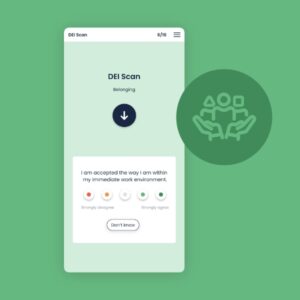Have you ever found yourself in a scenario at work where you advocated for a colleague? That’s allyship in action. But what does it really mean? Let’s explore the essence of allyship and how understanding its impact can help shape a healthier, more inclusive workspace.
Allyship Uncovered: How Your Actions Shape a Better Workplace

Understanding Allyship
In 2021, the term “allyship” has been spotlighted as the word of the year by Dictionary.com, underscoring its growing relevance in our daily interactions at work, school, and home. At its core, allyship means advocating and actively promoting the inclusion of marginalized or politicized groups in all facets of society. It means standing in solidarity with their struggles and perspectives, without seeking special recognition for these actions1.
Allyship means advocating and actively promoting the inclusion of marginalized or politicized groups in all facets of society.
Allyship in the workplace is about using our personal privileges to uplift colleagues from historically marginalized backgrounds. It’s about recognizing these advantages and using them to make sure everyone has an equal shot at success. Through allyship, we can amplify the voices of our underrepresented coworkers, creating a culture that warmly welcomes Diversity, Equity, and Inclusion (DEI)2.
Start Your DEI Scan Today
Assess your organization’s DEI efforts with Effectory’s DEI Scan. Get a clear baseline, actionable data, and a manager’s toolkit to guide your DEI journey.
Start your DEI Scan todayAllyship vs. Advocacy vs. Mentorship
When we talk about support in the workplace, allyship brings a more active engagement to the table. Unlike advocacy, which might involve speaking on behalf of others, or mentorship which often centers around providing guidance and advice, allyship emphasizes standing alongside colleagues, empathizing with their experiences, and actively fighting for workplace fairness. In other words, allyship is about forming authentic connections and taking part in actions that move us towards a more inclusive work environment3 4.
The positive impact of allyship on workplace culture and employee wellbeing is quite profound. It fosters psychological safety, which enables employees to share their unique ideas freely. This, in turn, can foster innovation and collaboration. Allies challenge biases and advocate for fair policies, creating a more inclusive and equitable environment5.
Read also: How to measure employee inclusion.
Allyship as a Business Strategy
Employees are 50% less likely to leave, 56% more likely to improve their performance, and instances of employees feeling left out are reduced by 75%.
Promoting allyship in your organization does not only create a positive and welcoming atmosphere; it also paves the way for tangible business outcomes, such as improved employee engagement, retention, and ultimately, higher productivity.
Research shows that in organizations where allyship and inclusion are well-rooted, employees are 50% less likely to leave, 56% more likely to improve their performance, and instances of employees feeling left out are reduced by 75%6. By valuing diverse perspectives, you set the stage for innovation which, in turn, can contribute to revenue growth.
How to be an Ally
Being an ally is about focusing on others, not yourself. You don’t need to agree with someone to empathize with their situation. Being an ally in your workplace requires blending certain traits:
- Self-awareness & self-education: Recognizing your biases and staying updated on DEI matters is the first step towards becoming a reliable ally.
- Courage: Having the courage to speak up against injustices is essential, even if it goes against popular opinion. It’s about standing firm when facing inequity.
- Active listening: It’s important to value and listen to the experiences of our coworkers, especially those often overlooked. This leads to a more inclusive environment.
- Empathy: Showing understanding and compassion for the challenges others face encourages supportive actions. It’s about feeling and acting in solidarity with others7.
Allyship in Everyday Scenarios
Allyship doesn’t mean doing grand gestures; it can be applied in everyday situations at work. Let’s look at some examples that highlight the simple yet impactful ways allyship can be part of daily work:
Addressing Microaggressions*:
- Scenario: During a team meeting, a colleague makes an offhand remark that belittles another coworker based on their accent.
- Allyship in Action: An ally could address the comment either during the meeting or afterward, expressing why it was inappropriate and fostering a dialogue about respect and understanding.
*Microaggressions are subtle, often unintentional, remarks or actions that display prejudiced attitudes towards members of a marginalized group.
Combatting Discrimination:
- Scenario: A coworker is overlooked for a promotion due to unconscious biases.
- Allyship in Action: Allies can advocate for a fair review process, ensuring that promotions are based on merit and not tainted by biases.
Mitigating Bias:
- Scenario: During a hiring process, the Hiring Manager unconsciously leans towards candidates who share similar backgrounds with them.
- Allyship in Action: By recognizing this bias and advocating for a more diverse shortlist, allies help in fostering a more inclusive recruitment process.
Strategies to Cultivate Allyship in Organizations
Organizations can foster a culture of allyship through training programs, regular workshops, and leadership-led initiatives that promote inclusion and support8. Additionally, a crucial aspect in cultivating allyship is tuning into the perspectives and experiences of employees. This can be done through a DEI Scan. Conducting this scan is a good first step, as it provides clear insights into how your employees perceive their workplace, revealing both the strengths and areas needing improvement within your organizational culture.
Leadership Buy-in and Accountability
Successful allyship relies on the support and active involvement of leadership. Leaders who demonstrate allyship behaviors set a positive example for the entire organization, encouraging a culture where inclusivity is valued and pursued.
Program Design and Implementation
Creating allyship programs that fit the specific needs of the organization is essential. This includes designing training sessions, starting conversations, and building platforms for ongoing learning and engagement.
Measuring Impact and Iterating
It’s important to set the right metrics to understand the effectiveness of your allyship initiatives. Continuous assessment and feedback help adjust your strategies in alignment with your DEI goals.
How do you know if your DEI initiatives are genuine? We explored this topic in a recent podcast episode – Listen here.
Valuing employee voices and experiences
A straightforward way for an organization to advance its allyship and DEI initiatives is by tuning into the experiences and viewpoints of its employees. When feedback is listened to and acted upon, it validates employees’ contributions and gives the organization a clear picture of its DEI standing.
Effectory’s DEI Scan can help in this regard. It evaluates critical aspects of DEI, such as:
- Fair treatment
- Integrating differences
- Decision making
- Psychological safety
- Trust
- Belonging
- Diversity
The level to which employees agree with these statements helps assess the inclusivity of your organization, highlighting both its strengths and areas for improvement.
Conclusion
Allyship in the workplace is more than just being a good colleague; it creates a harmonious work environment and positively impacts business outcomes by fostering innovation, enhancing employee retention, and improving overall productivity. By actively engaging in allyship, we move a step closer to creating workplaces where everyone has a fair shot at success, irrespective of their background.
Get a clear picture of where your organization stands on these fundamental aspects. Delve into the reality, learn from it, and start making data-driven decisions towards cultivating a more inclusive workplace.
Start your DEI Scan today
Assess your organization’s DEI efforts with Effectory’s DEI Scan. Get a clear baseline, actionable data, and a manager’s toolkit to guide your DEI journey.
Start your DEI Scan today